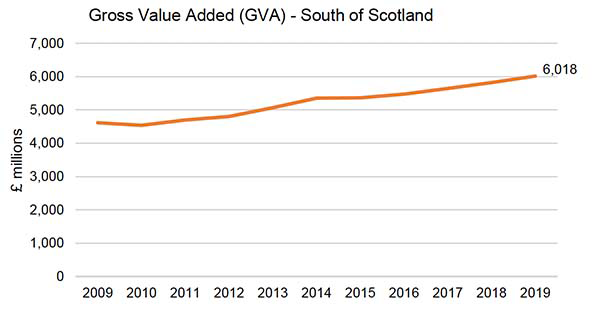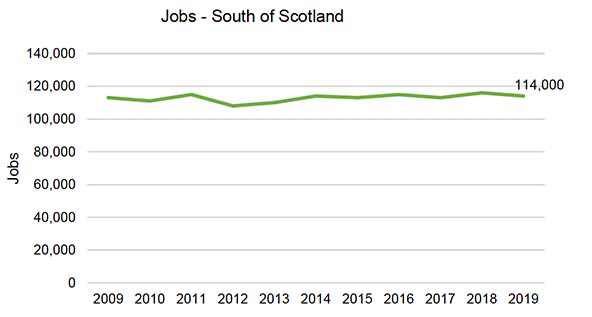Scotland National Strategy for Economic Transformation: Regional Economic Partnerships - evidence
This Paper provides summary evidence received from Scotland's Regional Economic Partnerships as part of the National Strategy for Economic Transformation engagement process.
7. South of Scotland Regional Economic Partnership


Regional Aspirations to 2030
The vision for the South of Scotland is to be Green, Fair and Flourishing by 2031. The South of Scotland Regional Economic Strategy has a 10-year timeframe and targets a significant shift in the region's economic performance, its outward profile and the way by which wealth is created and shared. It also seeks a renewed focus on the region's exceptional quality of life and natural capital, to attract a new generation of residents, workers, learners, visitors and investors to the South of Scotland.
The region's ambition is described under six themes:
- Skilled and ambitious people;
- Innovative and enterprising;
- Rewarding and fair work;
- Cultural and creative excellence;
- Green and sustainable economy; and
- Thriving and distinct communities.
Regional Opportunities
The South of Scotland Regional Economic Partnership area:
- has natural assets and resources to be at the forefront of responding urgently to maintaining nature and actioning the Just Transition to a Net Zero economy;
- can leverage its identity and distinctiveness to secure new opportunities and markets in a period of changing global trading conditions post the UK's exit from the EU;
- is well placed to capitalise on and to increase its profile as a place to do business and live and thus grow and thrive, based on its quality of life, natural capital and investment pipeline;
- has forecast growth and job opportunities in existing key sectors within the region, including health and social care; hospitality; tourism (including outdoor and adventure); construction; wholesale and retail trade; arts, entertainment and recreation and land based industries ;
- has strong and diverse cultural and historic identities and creative industries, built on the particular sense of place and community experience across the South of Scotland; and,
- can build on the agreed funding through the Borderlands Inclusive Growth Deal and the Edinburgh and South East Scotland City Region Deal to support key projects across the South of Scotland.
Regional Challenges
The region's main challenges include:
- a comparatively small and shrinking working age population;
- the need to build investment in all forms of research and innovation;
- weakness in digital infrastructure creating barriers to education and opportunity;
- lower productivity when GVA is used as a measure in comparison to other regions;
- lower skill levels in comparison to other parts of Scotland in working age population.
Ongoing and Planned Activity for Region
The Regional Economic Partnership was formed to strengthen the interface across the public, private and third sectors, to deliver a wellbeing economy, and to secure and enable inclusive and sustainable economic growth across the South of Scotland. It is championing the region and rasing its profile, with communities and voluntary bodies coming together to play an active role in the economy of the region, ensuring sustainable growth is fairly distributed across society and which creates opportunities for all.
The focus of the Regional Economic Strategy goes beyond the focus of traditional economic strategies, and include:
- supporting fairer, more meaningful work;
- finding and developing innovative and creative ways and solutions to bring out the full potential of our businesses and communities;
- transforming towns and town centres and supporting rural development and the resilience of our villages;
- increasing the attraction of the region as a place to live, work and visit;
- developing a stronger offering on developing skills, training, learning and education provision in all its forms and to all ages working in collaboration between schools, colleges and university and other providers;
- creating affordable, desirable and energy-efficient homes and widening housing choice;
- reducing poverty and deprivation;
- building the capability and capacity of social enterprises and the third sector;
- investing in social infrastructure and education to enhance life prospects;
- putting the environment and sustainability at the forefront of growing our economy and communities;
- improving the health and welfare of the most disadvantaged within the region;
- protecting, enhancing and enjoying our abundant natural capital, cultural and heritage assets, and vibrant arts and festivals backdrop;
- building wealth which benefits the local economy, our communities and people (Community Wealth Building), including supporting the development of local supply chains and looking at how to create bigger opportunities; and,
- the Strategy will be used alongside a delivery plan to align partner aims and objectives.
Contact
Email: Cornilius.Chikwama@gov.scot
There is a problem
Thanks for your feedback